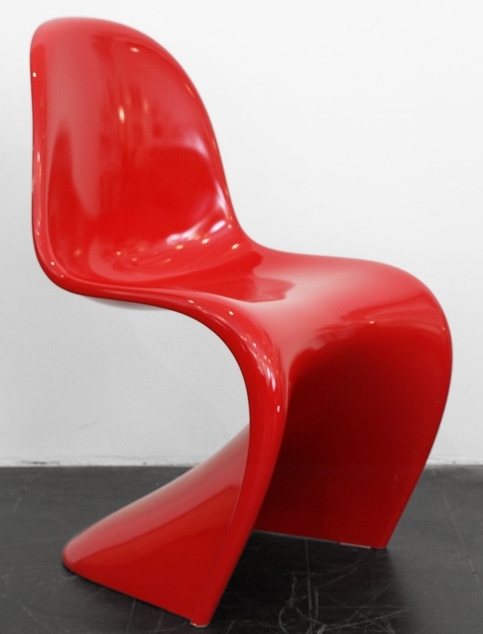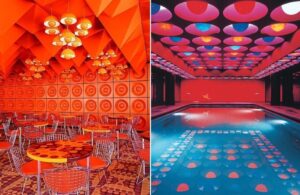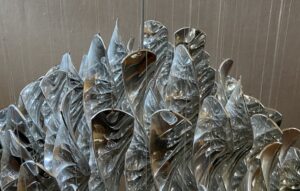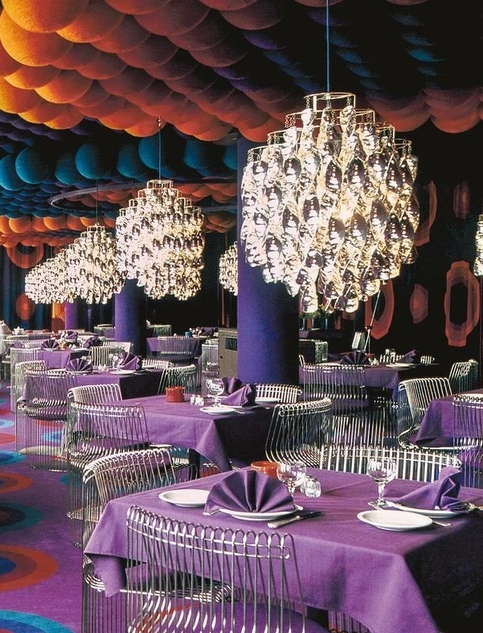Verner Panton’s spectacular spiral silver pendant light
This double spiral, SP2 ceiling light in chromium plated ABS plastic, was designed in 1969 by Verner Panton – considered to be one of Denmark’s most influential 20th century furniture and interiors designers.
Born in 1926 in Gentofte, a small village north of Copenhagen, Panton studied architecture at the Royal Danish Academy of Art and graduated in 1951. He initially worked at the architectural practice of Arne Jacobsen, a major exponent of architectural functionalism – where the design of a building is informed by its purpose and function. Panton’s stretch at the firm coincided with Jacobsen’s increasing interest in furniture design, as building projects became all-encompassing and extended to interiors, their components, fixtures and decoration.

Verner Panton (1926-1988)
Panton broke away from Jacobsen and set up his own design and architectural office in 1955, and created a series of novel architectural schemes – a Collapsible House (1955), the Cardboard House (1957) and the Plastic House (1960). In 1956 he designed the ‘S’ chair, although the idea of creating a stackable chair in plastic was first explored by the German architect and designer Mies van der Rohe before World War II, Panton was also fascinated by the challenge of producing a cantilevered chair in one piece. It was finally manufactured in 1965, through collaboration with Willi Fehlbaum, of Vitra, the furniture manufacturer. Together they fashioned a cold-pressed model in polyester strengthened with fibreglass – a single-piece chair without legs. The chair went through several iterations in various materials before it could be produced on an industrial scale, and it is now to be found in the permanent collections of several of the world’s most famous design museums.

Panton’s ‘S’ chair
From the late 1960s Verner Panton experimented with his own interpretation of total environments – radical and psychedelic interiors uniting his curved furniture, wall upholstery, textiles and lighting. He produced innovative office interiors for Der Spiegel, the German weekly news magazine based in Hamburg which in 1969 had moved into modernised premises on Ost-West Street. The remit covered both public and private areas, and each floor had its own chromatic order which unfolded across murals and floors through shapes produced using moulds and numerous materials. The company canteen was dominated by spherical and conical patterns and was transformed into a three-dimensional installation. The editorial floor was created in sombre, cold tones, the administration floor and bar in fizzing red, yellow and orange, with the meeting rooms utilising an intense lilac. The employees’ swimming pool presented Panton with the opportunity to create an intoxicating experience through the interaction of coloured light with water. Der Spiegel’s offices were re-designed in the 1990s, with only the canteen remaining as Panton had originally designed it.

Interiors at Der Spiegel’s Hamburg offices: the canteen and swimming pool
His lighting designs demonstrate Panton equally preoccupied with colours and shapes, and light’s ability to affect spatial surroundings. The SP2 is a cluster of two pendants, with each spiral suspended from a nylon string stemming from the ceiling canopy. This model, along with several related versions, was designed for the 1970 Cologne Furniture Fair.

Detail of the light’s acrylic spirals suspended from nylon strings
A year later Panton was commissioned to design a restaurant within the Varna Palace, at Aarhaus; situated on the east coast of the Jutland peninsula, the renovated, neo-classical building dated from 1909. For the interior he looked outside to the circular columns of the building itself and created an internal rotunda, at its heart a rich red sculpture based on the design of his ball lamp, with his ‘S’ chairs grouped around each dining table. Beyond the focus of the main eating area the surrounds were dressed in purple, the carpets and curtains in the connecting corridors of the restaurant were adorned with colourful spirals, thereby intensifying the colour-saturated experience. Within the purple zone of the restaurant Panton hung the single pendant light, the SP1.

Panton’s bold patterns and palette dressed the connection passages at the Varna Palace restaurant | The SP1 installed in the Varna Palace restaurant

